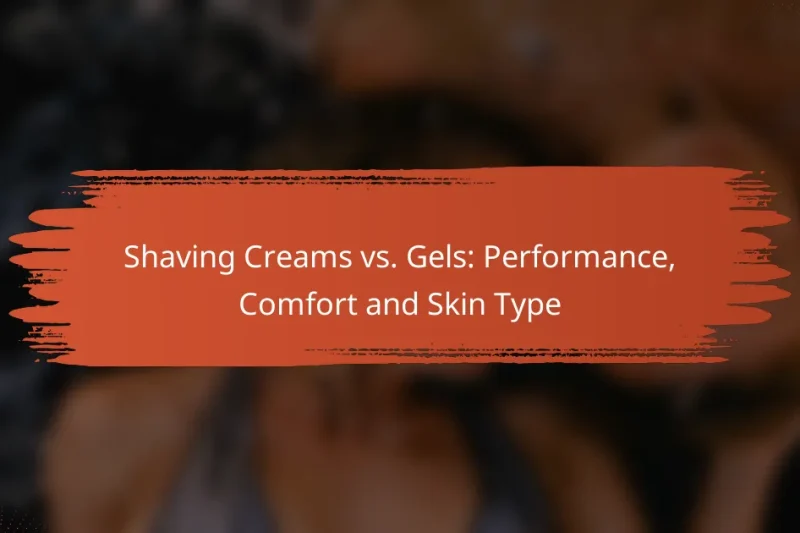Shaving techniques vary significantly based on individual skin types, making it essential to choose the right … Shaving Techniques: Methods, Tools and Skin TypesRead more
Effective Shaving Techniques
Effective shaving techniques are essential for achieving a close and comfortable shave while minimizing irritation, especially for those with sensitive skin. By focusing on proper preparation, using the right tools, and following specific methods, you can enhance your shaving experience and protect your skin. Key practices include exfoliation, warm water application, and maintaining sharp blades to ensure a smooth finish.
Preventing Razor Burn: Causes, Solutions and Aftercare
Razor burn is a common issue that arises from skin irritation after shaving, often resulting in … Preventing Razor Burn: Causes, Solutions and AftercareRead more
Best Razors for Sensitive Skin: Features, Benefits and Recommendations
Finding the best razors for sensitive skin is essential for achieving a comfortable and irritation-free shaving … Best Razors for Sensitive Skin: Features, Benefits and RecommendationsRead more
Perfect Shave: Techniques, Tools and Products
A perfect shave requires a combination of effective techniques, quality tools, and the right products. By … Perfect Shave: Techniques, Tools and ProductsRead more
Best Aftershaves: Ingredients, Benefits and Application
Choosing the right aftershave is essential for enhancing post-shave comfort and skin health. The best options … Best Aftershaves: Ingredients, Benefits and ApplicationRead more
Electric Shavers vs. Traditional Razors: Which Is Better and When to Use
When it comes to grooming, choosing between electric shavers and traditional razors can significantly impact your … Electric Shavers vs. Traditional Razors: Which Is Better and When to UseRead more
Shaving Creams vs. Gels: Performance, Comfort and Skin Type
When choosing between shaving creams and gels, understanding their distinct characteristics can greatly enhance your shaving … Shaving Creams vs. Gels: Performance, Comfort and Skin TypeRead more
What are the best shaving techniques for sensitive skin?
The best shaving techniques for sensitive skin focus on minimizing irritation and ensuring a smooth finish. Key practices include using the right products and tools, as well as following specific shaving methods to protect the skin.
Use a moisturizing shaving cream
A moisturizing shaving cream is essential for sensitive skin as it hydrates and protects the skin during shaving. Look for creams that contain natural ingredients like aloe vera or shea butter, which can help soothe irritation.
Apply a generous amount of shaving cream and let it sit for a minute to soften the hair. This can make the shaving process smoother and reduce the risk of nicks and cuts.
Opt for a single-blade razor
Using a single-blade razor is often recommended for sensitive skin because it reduces the chances of irritation and razor burn. Multi-blade razors can tug at the hair and cause more friction, leading to discomfort.
When using a single-blade razor, ensure it is sharp and clean. Dull blades can cause more irritation, so replace them regularly to maintain a comfortable shave.
Shave in the direction of hair growth
Shaving in the direction of hair growth helps minimize irritation and prevents ingrown hairs. This technique allows the razor to glide smoothly over the skin without pulling the hair.
Take your time and use gentle strokes. If you need a closer shave, consider going against the grain only after the initial pass, but be cautious as this can increase the risk of irritation.
Apply aftershave balm
Applying an aftershave balm is crucial for soothing sensitive skin post-shave. Look for alcohol-free balms that contain calming ingredients like chamomile or witch hazel to reduce redness and irritation.
Gently massage the balm into the skin after shaving to help lock in moisture and promote healing. This step can significantly enhance comfort and prevent dryness throughout the day.
How can I achieve a close shave without irritation?
To achieve a close shave without irritation, focus on preparation and technique. Proper exfoliation, using warm water, and changing blades regularly can significantly reduce the risk of skin irritation and enhance the closeness of your shave.
Exfoliate before shaving
Exfoliating your skin before shaving removes dead skin cells and helps prevent ingrown hairs. Use a gentle scrub or an exfoliating glove to prepare your skin, ideally a few minutes before you start shaving.
Consider exfoliating 2-3 times a week, depending on your skin type. For sensitive skin, opt for a mild exfoliant to avoid irritation.
Use warm water to soften hair
Warm water softens hair and opens up pores, making it easier to achieve a close shave. Splash your face with warm water or shave after a warm shower for optimal results.
Aim for water temperatures around 37-40 degrees Celsius (98-104 degrees Fahrenheit) to ensure comfort while effectively preparing your hair for shaving.
Change blades regularly
Regularly changing your razor blades is crucial for a close shave without irritation. Dull blades can tug at hair and irritate the skin, leading to discomfort.
As a rule of thumb, replace your blades after 5-7 shaves or sooner if you notice pulling or discomfort. Keeping a consistent schedule will help maintain the quality of your shave.
What tools are essential for effective shaving?
To achieve a close and comfortable shave, a few essential tools are necessary. These include a high-quality razor, a shaving brush, and pre-shave oil, each contributing to a smoother shaving experience.
High-quality razor
A high-quality razor is crucial for effective shaving as it reduces the risk of nicks and irritation. Look for razors with sharp, replaceable blades, as they provide a cleaner cut and require less pressure during use.
Consider the type of razor that suits your needs: safety razors offer a balance of safety and closeness, while straight razors provide the closest shave but require more skill. Regularly replacing blades is essential for maintaining performance.
Shaving brush
A shaving brush helps create a rich lather and lifts hair for a closer shave. Opt for brushes made from badger hair or synthetic fibers, as they hold water well and distribute shaving cream evenly.
When using a brush, wet it and apply your shaving cream or soap in circular motions. This not only enhances lather but also exfoliates the skin, preparing it for shaving.
Pre-shave oil
Pre-shave oil acts as a lubricant, reducing friction between the razor and skin. Applying a few drops before shaving can significantly enhance comfort and minimize irritation.
Choose a pre-shave oil with natural ingredients like jojoba or almond oil for added skin benefits. Apply it to damp skin and massage it in before using your shaving cream or soap for the best results.
What are the common mistakes in shaving?
Common mistakes in shaving include not preparing the skin properly, using dull blades, and rushing through the process. These errors can lead to irritation, cuts, and an overall unsatisfactory shave.
Shaving dry skin
Shaving on dry skin is a frequent mistake that can cause irritation and discomfort. It’s essential to hydrate the skin before shaving, as this softens the hair and reduces friction.
To prepare your skin, consider using warm water or a pre-shave oil. Allowing your skin to absorb moisture for a few minutes can significantly improve the shaving experience.
Using dull blades
Using dull blades is another common error that can lead to nicks and an uneven shave. Dull blades tug at the hair rather than cutting it cleanly, which increases the risk of irritation.
Replace your razor blades regularly, ideally after 5-7 shaves, depending on hair thickness and shaving frequency. A sharp blade ensures a smoother shave and minimizes skin damage.
Rushing the process
Rushing through shaving can result in careless mistakes, such as missing spots or applying too much pressure. Taking your time allows for a more thorough and careful shave.
Set aside at least 10-15 minutes for your shaving routine. This time allows for proper preparation, shaving, and aftercare, leading to better results and healthier skin.
How do I choose the right shaving cream?
Choosing the right shaving cream is essential for a smooth and comfortable shave. Look for products that suit your skin type and provide adequate lubrication and hydration.
Look for hydrating ingredients
Hydrating ingredients in shaving creams help to moisturize the skin and reduce irritation during shaving. Common hydrating components include glycerin, aloe vera, and natural oils like coconut or jojoba oil.
When selecting a shaving cream, check the ingredient list for these hydrating elements. Products containing at least one or two of these ingredients are generally more effective at preventing dryness and razor burn.
Avoid alcohol-based products
Alcohol-based shaving creams can strip moisture from the skin, leading to irritation and discomfort. These products often cause a burning sensation and can exacerbate skin sensitivity.
To ensure a gentler shaving experience, opt for creams labeled as alcohol-free. Look for alternatives that prioritize soothing and moisturizing properties to maintain skin health during and after shaving.
What are the benefits of electric razors?
Electric razors offer several advantages, including convenience, speed, and reduced skin irritation. They are particularly beneficial for individuals with sensitive skin or those who prefer a quick grooming routine.
Convenience and Speed
Electric razors are designed for quick use, allowing you to shave without the need for shaving cream or water. This makes them ideal for busy mornings or travel situations where time and resources are limited.
Many models also feature cordless operation, enabling you to shave anywhere without being tethered to an outlet. This portability enhances their convenience, making them a popular choice among users.
Reduced Skin Irritation
One of the key benefits of electric razors is their ability to minimize skin irritation. Unlike traditional razors, which can cause nicks and cuts, electric razors often glide over the skin without direct contact, reducing the risk of injury.
For those with sensitive skin, electric razors equipped with hypoallergenic blades can further decrease the likelihood of irritation and razor burn. This makes them a safer option for daily use.
Cost-Effectiveness
While electric razors may have a higher initial purchase price compared to disposable razors, they can be more cost-effective in the long run. With proper maintenance, electric razors can last for several years, eliminating the need for frequent replacements.
Additionally, many electric razors come with rechargeable batteries, reducing the ongoing cost of purchasing replacement batteries. This can lead to significant savings over time.






